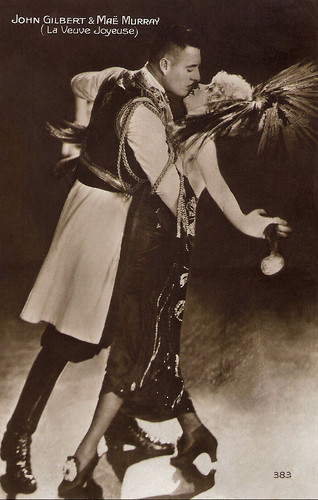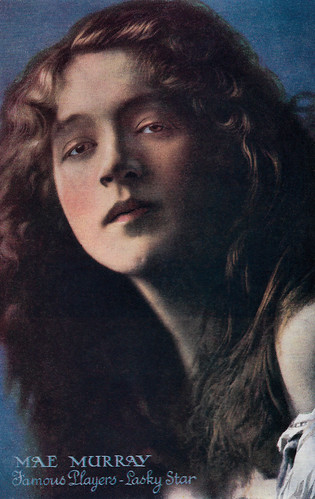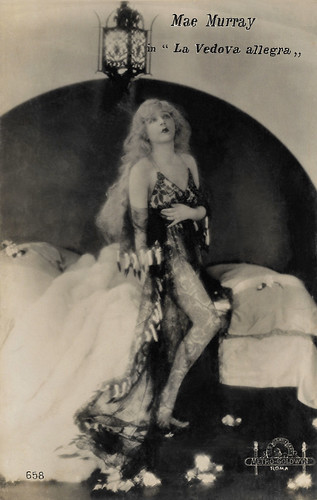
French postcard by Editions Cinémagazine, no. 370. Mae Murray in Circe the Enchantress (Robert Z. Leonard, 1924).

French postcard by Cinémagazine-Edition, Paris, no. 33. Photo: Paramount Pictures.

French postcard by Cinémagazine-Edition, Paris, no. 351.

French postcard by Cinémagazine-Edition, Paris, no. 383. Photo: Metro-Goldwyn-Film. Publicity still for The Merry Widow (Erich von Stroheim, 1925) with John Gilbert.

French postcard, editor unknown. Publicity still for The Masked Bride (Christy Cabanne, Josef von Sternberg, 1925).

Austrian postcard by Iris Verlag, no. 559. Photo: Metro-Goldwyn-Film. Publicity still for The Merry Widow (Erich von Stroheim, 1925) with John Gilbert.

Austrian postcard by Iris Verlag, no. 794/2. Photo: Fanamet.
Lifting up her nose and showing her teeth
Mae Murray always said she was born Marie Adrienne Koenig in Portsmouth in 1885. The incorrigible Murray however loved to reinvent her past. Michael Ankerich, who wrote a well-documented biography about her, has found in the City of New York birth registers that she was born in New York as Anna Mary Koenig. She was the second-oldest child of Joseph and Mary (née Miller) Koenig, both children of European emigres. In May 1896, Joseph Koenig died from acute gastritis due to his alcoholism. To support the family, Mary Koenig took a job as a housekeeper for businessman Harry Payne Whitney. Ankerich also did intensive research on the beginnings of Mae’s career, trying to set the record straight. Mae made her Broadway debut in 1904 in the chorus of 'The Sho-Gun'. In 1908 she became a chorus girl at the Ziegfeld Follies. Among her many dance partners was the young Clifton Web in 1914. Murray replaced Irene Castle in Irving Berlin’s 'Watch Your Step' for one week at the end of January 1915. Later in 1915, she became the leading lady at Ziegfeld. Her first number immediately stunned the star-studded opening night audience. People screamed and threw flowers at her feet on the stage.
Mae soon became accustomed to her own celebrity, the companionship of high society, and the attention of millionaires anxious to be seen with the latest toast of Manhattan on their arms. In September 1908, in Hoboken, New Jersey, while she was appearing in the Follies of 1908, Murray married William M. Schwenker, Jr., the unemployed son of a brewery supply dealer, who cut off his son's allowance upon news of the wedding. The pair divorced in 1910. In 1916, she married former dancer and future Olympic bobsled champion Jay O'Brien. They divorced in 1918. Adolph Zukor signed her to a screen contract with Paramount. Her film debut was in the silent adventure drama To Have and to Hold (George Melford, 1916) with Wallace Reid. In the following years, Murray acted in a string of box office hits, including The Dream Girl (Cecil B. DeMille, 1916) with Theodore Roberts, and A Mormon Maid (Robert Z. Leonard, 1917), in which she played alongside then-actor Frank Borzage. Director and producer Robert Z. Leonard became her third husband.
With Robert Z. Leonard, she joined Universal to open her own production unit, Bluebird, and Leonard directed most of Murray’s films in the late 1910s and early 1920s. Many of their films, contained dance sequences which were designed especially for her. In 1919, she paired up with friend and former dance partner Rudolph Valentino in The Delicious Little Devil (Robert Z. Leonard, 1919) and Big Little Person (Robert Z. Leonard, 1919). These 'silent musicals' were usually constructed on a framework of light romance or comedy set in exotic locales or historical settings. Elaborate decor and magnificent costumes enriched the visuals. Their success made Mae Murray into one of Universal's biggest stars. Mae became a defining example of silent film excess. She was promoted in all the fanzines flaunting the lifestyle expected of Hollywood royalty, spending her millions on jewellery, motorcars, racehorses, and couture. In 1922, 'The Girl with the Bee-Stung Lips' started acting at Metro (later MGM). With her husband Robert Z. Leonard and M.H. Hoffman, she founded Tiffany Productions (1921-1933).
Murray and Leonard signed with Louis B. Mayer to make films for Metro under the Tiffany label. They made eight films together, showcasing Murray’s extravagant and florid performance style. After Circe the Enchantress (Robert Z. Leonard, 1924), Murray and Leonard parted. They officially divorced in 1925. While her films with Leonard were successful at the box office, the critics didn’t like them, because of her exaggerated emotions and her over-the-top costumes. Her overacting, lifting up her nose and showing her teeth, was parodied by Marion Davies in the delicious comedy The Patsy (King Vidor, 1928). Although Murray’s presence can be considered excessive and baroque, her fans called her 'The Gardenia of the Screen'. She pleasurably perfumed and intensified the audience experience of her 'silent musicals', of which the scores were performed by large orchestras in the movie palaces in the cities, while smaller venues used giant Wurlitzer organs. Her many fans revelled thus in her colourful performances.
Her most famous role is The Merry Widow (Erich von Stroheim, 1925). John Gilbert plays a prince, who must woo the now wealthy dancer he once abandoned in order to keep her money in the country in order to keep it from crashing economically. The reception for the film was superlative. Critics praised the artistic choices, such as the colours in the wedding sequence at the film’s end. Mordaunt Hall in The New York Times: "The Widow is, of course, impersonated by Mae Murray, who demonstrates true acting ability in this effort. Hitherto she was like a top, and one seldom caught much more than a flash of her face. Here she stands still; she wears her costumes with a full realization of their splendor." The Merry Widow boasted the largest box office for any Hollywood studio in 1925 and would remain the most successful film both Murray and von Stroheim ever made.

British postcard. Photo: Famous Players-Lasky.

British postcard in J.D. Walker's "World's Film Series". Photo: Lasky.

French postcard by Editions Filma in the Les Vedettes du Cinéma series, no. 41. Photo: John Hill / Films Pathé.

Italian postcard by Vettori, Bologna, no. 127. Photo: Paramount Pictures.

Italian postcard by G. Vettori, Bologna, no. 471. Photo: Ernest Bachrach / Paramount Pictures. Publicity still for The Gilded Lily (Robert Z. Leonard, 1921).

Italian postcard by G. Vettori, Bologna, no. 464. Photo: Ernest Bachrach / Paramount Pictures. Publicity still for The Gilded Lily (Robert Z. Leonard, 1921) with Monte Blue.

Italian postcard by G.B. Falci, Milano. Photo: MGM. Publicity still for The Merry Widow (Erich von Stroheim, 1925).

Italian postcard by Casa Editrice Ballerini & Fratini, Firenze, no. 658. Photo: Metro-Goldwyn, Roma. Mae Murray in The Merry Widow (Erich von Stroheim, 1925).
Doing all to mask her age
Mae Murray's fourth husband was ‘Prince’ David Mdivani, a Georgian man of minor aristocratic roots, whose brothers Serge and Alexis married actress Pola Negri and the heiress Barbara Hutton respectively. The father of the 'marrying Mdivani' trio, later admitted that he was the only Prince to ever inherit a title from his sons. When Mae let her prince take control of her business affairs, he ill-advised her to quit MGM. So, Murray made a scene at the studio, stepped out of her contract, and left Louis B. Mayer in 1927. Later, blacklisted by Mayer, she sorely regretted this.
When sound film came along, Mae Murray’s voice didn’t fit her image. Murray made an insecure sound debut in Peacock Alley (Marcel de Sano, 1930), a remake of her silent hit Peacock Alley (Robert Z. Leonard, 1921). Produced by Tiffany Pictures, the film was lavishly produced with elaborate sets despite its low budget. But the fortunes of Tiffany Pictures had now come to an end. In her next sound film, Bachelor Apartment (Lowell Sherman, 1931), she co-starred with newcomer Irene Dunne, Lowell Sherman, and Norman Kerry. After another RKO production, High Stakes (Lowell Sherman, 1931), she left the film business for good. At Silents Are Golden, J. Stephen Walters writes about her final films: "In these, a capable voice proves equal to sound, but the films otherwise present Mae disastrously - badly photographed low-budget productions, clearly showing her age."
Prince Mdivani had spent all of her money and the couple divorced in 1934. Later, there was a nasty custody battle about their son Koran David Mdivani, born in 1927. After two years, when she finally was given custody, she was unable to care for her son due to financial and personal problems. In 1940, he was adopted by his foster family and his name was changed to Daniel Michael Cunning. In 1934, Murray returned to Broadway briefly to perform in The Milky Way. In the 1940s, she performed an act at the Times Square establishment Billy Rose's Diamond Horseshoe nightclub. Her dancing in the Merry Widow Waltz was well received, but she was criticised for her youthful costumes and heavy makeup application, doing all to mask her age. In 1946, she taught ballroom dancing to young teenagers at a dance studio in Los Angeles.
In her later years, Mae Murray suffered from financial problems and lived in poverty. In 1959, she was the subject of an authorised biography, 'Mae Murray - The Self-Enchanted', written by Jane Ardmore. Reportedly it sold poorly. Mae ended her days in the Motion Picture Country Home in Woodland Hills in Los Angeles. There she passed away of heart failure in 1965 at the age of 79. She only left a trunk containing clothing and keepsakes.
In the early 1990s, the Eye Filmmuseum (formerly Nederlands Filmmuseum) found two early Mae Murray films, which she made for Universal: The Delicious Little Devil (Robert Z. Leonard, 1919), with the young Rudolph Valentino, and The ABC of Love (Léonce Perret, 1919). Eye also found and restored Murray’s film The Right to Love (George Fitzmaurice, 1920), a Famous Players-Lasky production.

German postcard by Ross Verlag, no. 825/1, 1925-1926. Photo: British-American-Films A.G. (Bafag). Publicity still for Peacock Alley (Robert Z. Leonard, 1922).

German postcard by Ross Verlag, no. 843/1, 1925-1926. Photo: British-American-Films A.G. (Bafag). Publicity still for Broadway Rose (Robert Z. Leonard, 1922).

German postcard by Ross Verlag, no. 843/3, 1925-1926. Photo: British-American Film A.G., Berlin (BAFAG). Publicity still for Broadway Rose (Robert Z. Leonard, 1922).

Italian postcard by Casa Editrice Ballerini & Fratini, no. 608. Photo: Metro-Goldwyn-Mayer, Roma. Mae Murray and Lloyd Hughes in Valencia (Dimitri Buchowetzki, 1926).

French postcard by A.N, Paris, no. 36. Photo: Metro-Goldwyn Production. Publicity still for Valencia (Dimitri Buchowetzki, 1926) with Lloyd Hughes.

German postcard by Ross Verlag, no. 1296/2, 1927-1928. Photo: Loew-Metro-Goldwyn.

German postcard by Ross Verlag, no. 2013/1, 1927-1928. Photo: Parufamet.

German postcard by Ross Verlag, no. 3253/2, 1928-1929. Photo: Metro-Goldwyn-Mayer.

German postcard by Ross Verlag, no. 3335/1, 1928-1929. Photo: Metro-Goldwyn-Mayer.

Austrian postcard by Iris Verlag, no. 794/1. Photo: Fanamet.
Sources: Mordaunt Hall (The New York Times), Artemis Willis (Women Film Pioneers Project), J. Stephen Walters (Silent Are Golden), Jimmy Bangley (Classic Images), Gary Brumburgh (IMDb), Wikipedia (English and Dutch), and IMDb. Thanks to Marlene Pilaete.
No comments:
Post a Comment